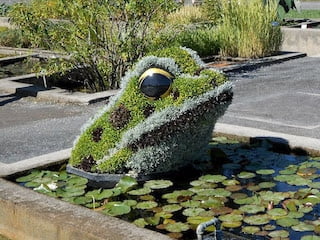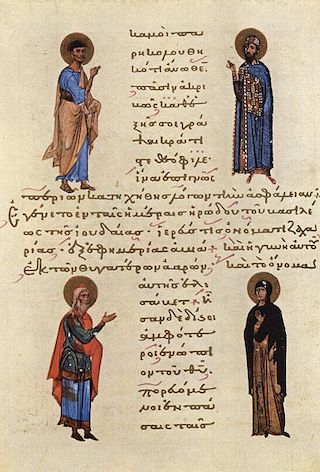 The below pictures are from the International Mosaiculture Exhibition – Montreal – Summer 2013.
The below pictures are from the International Mosaiculture Exhibition – Montreal – Summer 2013.
Since the Gospels are all basically the same it’s not so easy to find different themes and pictures so tomorrow we’re going to look at another Great Empire, the…
Luke 2
The Birth of Jesus

1 And it came to pass in those days, that there went out a decree from Caesar Augustus, that all the world should be taxed.
Luke is the only Gospel writer who relates his narrative to dates of world history.
“Cesar Augustus” – the first and (according to many) greatest Roman emperor (31 B.C.-14 A.D.).
Having replaced the republic with an imperial form of government, he expanded the empire to include the entire Mediterranean world, established the famed Pax Romana (“Roman Peace”) and ushered in the golden age of Roman literature and architecture.
August (which means “exalted”) was a title voted to him by the Roman senate in 27 B.C.
“The world” – the Roman world.
“Taxed” – this was a type of census or enrollment used for military service and taxation. Jews, however, were exempt from Roman military service. God used the decree of a pagan emperor to fulfill the prophecy of Mic 5:2.
2 (And this taxing was first made when Cyrenius was governor of Syria.)

“Cyrenius” – this official was possibly in office for two terms, first 6- B.C. and then 6-9 A.D. a census is associated with each term. This is the first; Acts 5:37 refers to the second.
3 And all went to be taxed, every one into his own city.
4 And Joseph also went up from Galilee, out of the city of Nazareth, into Judaea, unto the city of David, which is called Bethlehem; (because he was of the house and lineage of David:)
Nazareth…Bethlehem” – Bethlehem” – Bethlehem, the town where David was born (1 Sam 17:12, 20:6), w at least a three-day trip from Nazareth.
“Judea” – Greco-Roman designation for the southern part of the Holy Land, earlier included in the kingdom of Judah.
5 To be taxed with Mary his espoused wife, being great with child.
“With Mary” – Mary too was of the house of David and probably was required to enroll. In Syria, the Roman province in which the Holy Land was located, women 12 years of age and older were required to pay a poll tax and therefore to register.
6 And so it was, that, while they were there, the days were accomplished that she should be delivered.
7 And she brought forth her firstborn son, and wrapped him in swaddling clothes, and laid him in a manger; because there was no room for them in the inn.

8 And there were in the same country shepherds abiding in the field, keeping watch over their flock by night.
9 And, lo, the angel of the Lord came upon them, and the glory of the Lord shone round about them: and they were sore afraid.
10 And the angel said unto them, Fear not: for, behold, I bring you good tidings of great joy, which shall be to all people.
11 For unto you is born this day in the city of David a Savior, which is Christ the Lord.
“City of David” – Bethlehem.
12 And this shall be a sign unto you; Ye shall find the babe wrapped in swaddling clothes, lying in a manger.
13 And suddenly there was with the angel a multitude of the heavenly host praising God, and saying,
14 Glory to God in the highest, and on earth peace, good will toward men.

This brief hymn is called the Gloria in Excelsis Deo, from the first words of the Latin Vulgate translation (meaning “Glory to God in the Highest”).
15 And it came to pass, as the angels were gone away from them into heaven, the shepherds said one to another, Let us now go even unto Bethlehem, and see this thing which is come to pass, which the Lord hath made known unto us.
16 And they came with haste, and found Mary, and Joseph, and the babe lying in a manger.
17 And when they had seen it, they made known abroad the saying which was told them concerning this child.
18 And all they that heard it wondered at those things which were told them by the shepherds.
19 But Mary kept all these things, and pondered them in her heart.
20 And the shepherds returned, glorifying and praising God for all the things that they had heard and seen, as it was told unto them.
21 And when eight days were accomplished for the circumcising of the child, his name was called JESUS, which was so named of the angel before he was conceived in the womb.

22 And when the days of her purification according to the law of Moses were accomplished, they brought him to Jerusalem, to present him to the Lord;
“Her purification” – following the birth of a son, the mother had to wait 40 days before going to the temple to offer sacrifice for her purification. If she couldn’t afford a lamb and a pigeon (or dove), then two pigeons (or doves) would be acceptable.
23 (As it is written in the law of the Lord, Every male that openeth the womb shall be called holy to the Lord;)
24 And to offer a sacrifice according to that which is said in the law of the Lord, A pair of turtledoves, or two young pigeons.
25 And, behold, there was a man in Jerusalem, whose name was Simeon; and the same man was just and devout, waiting for the consolation of Israel: and the Holy Ghost was upon him.
26 And it was revealed unto him by the Holy Ghost, that he should not see death, before he had seen the Lord’s Christ.

27 And he came by the Spirit into the temple: and when the parents brought in the child Jesus, to do for him after the custom of the law,
28 Then took he him up in his arms, and blessed God, and said,
29 Lord, now lettest thou thy servant depart in peace, according to thy word:
2:29-32 – This hymn of Simeon has been called the Nunc Dimittis, from the first words of the Latin Vulgate translation, meaning “now lettest…depart.”
30 For mine eyes have seen thy salvation,
31 Which thou hast prepared before the face of all people;
“All people” – as a Gentile himself, Luke was careful to emphasize the truth that salvation was offered to the Gentiles (v. 32) as well as to Jews.
32 A light to lighten the Gentiles, and the glory of thy people Israel.
33 And Joseph and his mother marveled at those things which were spoken of him.
34 And Simeon blessed them, and said unto Mary his mother, Behold, this child is set for the fall and rising again of many in Israel; and for a sign which shall be spoken against;
35 (Yea, a sword shall pierce through thy own soul also,) that the thoughts of many hearts may be revealed.

36 And there was one Anna, a prophetess, the daughter of Phanuel, of the tribe of Aser: she was of a great age, and had lived with an husband seven years from her virginity;
“Anna” – same name as Old Testament Hannah (1 Sam 1:2) which means “gracious>” Anna praised God for the child Jesus as Hannah had praised God for the child Samuel.
“Prophetess” – other prophetesses were Miriam (Ex 15:20), Deborah (Jud 4:4), Huldah (2 Kgs 22:14), and the daughters of Philip (Acts 21:9).
37 And she was a widow of about fourscore and four years, which departed not from the temple, but served God with fastings and prayers night and day.
38 And she coming in that instant gave thanks likewise unto the Lord, and spake of him to all them that looked for redemption in Jerusalem.
39 And when they had performed all things according to the law of the Lord, they returned into Galilee, to their own city Nazareth.

He accompanied his master to the railroad station ever morning when the man went
to work, and then the dog met him again in the evening. When the man died, the dog
continued meeting the train twice every day for ten years until he died. He is made up
of various decorative grasses. The horses’ manes are also made of grasses.
The horses are twice the size of a normal horse; the dog is 8 feet high.
40 And the child grew, and waxed strong in spirit, filled with wisdom: and the grace of God was upon him.
41 Now his parents went to Jerusalem every year at the feast of the passover.
42 And when he was twelve years old, they went up to Jerusalem after the custom of the feast.
“Twelve” – at age 12 boys began preparing to take their places in the religious community the following year.
43 And when they had fulfilled the days, as they returned, the child Jesus tarried behind in Jerusalem; and Joseph and his mother knew not of it.
44 But they, supposing him to have been in the company, went a day’s journey; and they sought him among their kinsfolk and acquaintance.
45 And when they found him not, they turned back again to Jerusalem, seeking him.
46 And it came to pass, that after three days they found him in the temple, sitting in the midst of the doctors, both hearing them, and asking them questions.
47 And all that heard him were astonished at his understanding and answers.
48 And when they saw him, they were amazed: and his mother said unto him, Son, why hast thou thus dealt with us? behold, thy father and I have sought thee sorrowing.

49 And he said unto them, How is it that ye sought me? wist ye not that I must be about my Father’s business?
“About my Father’s business” – Jesus’ father was God, not Joseph.
50 And they understood not the saying which he spake unto them.
51 And he went down with them, and came to Nazareth, and was subject unto them: but his mother kept all these sayings in her heart.
52 And Jesus increased in wisdom and stature, and in favor with God and man.
Birthplace of Jesus

The canonical gospels of Luke and Matthew both describe Jesus as born in Bethlehem in Judea, to a virgin mother. In the Gospel of Luke account, Joseph and Mary travel from Nazareth to Bethlehem for the census, and Jesus is born there and laid in a manger.[1] Angels proclaim him a savior for all people, and shepherds come to adore him.
Bethlehem of Judah, located at modern Bethlehem, was already an ancient habitation during Old Testament times. Gens 35:19 and 48:7 mention that the site was also called Ephrathah (or Ephrath), a name preserved in the prophecy of Mic 5:2.
This town is the principal setting for the book of Ruth, the great-grandmother of King David, as well as the home of David (Is 16). During David’s lifetime the city was sometimes under Philistine control (2Sam 23:14), although Rehoboam fortified it after the secession of the northern tribes (2 Chr 11:5-6).
The archaeology of Bethlehem has focused almost entirely upon historical tradition surrounding the Church of the Nativity. Justin Martyr in the 2nd century identified a cave near the village as the place of Jesus’ birth, and the church was built over this grotto.
Emperor Constantine constructed the first basilica there in approximately 326 A.D. While this building was badly damaged in a Samaritan revolt (529), the church was rebuilt by Justinian (r. 527-565).
The Christian population of Bethlehem severely declined after the Muslim conquest although the church building was restored to some of its former glory during the Crusader period. It fell into near ruin again during the period of Turkish rule, but repairs were made beginning in 1670.
To this day the church continues to be at the center of religious and political tensions.
…Byzantine Empire: The Creation of the Roman Empire.
Visits: 0
